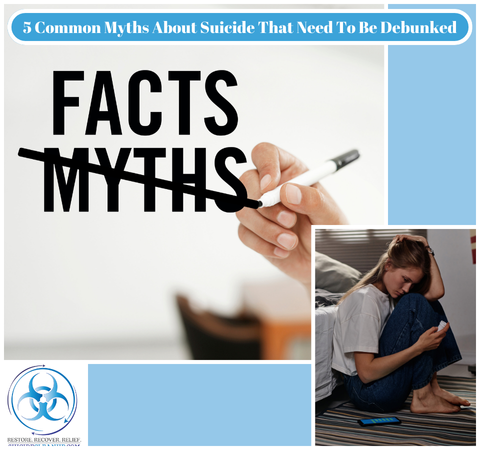
Remembering Sladjana Vidovic
September 26, 2022
What To Do When Your Child Is Suicidal
October 12, 2022Men are more likely to die by suicide than women, though clinical depression diagnoses occur at a much lower rate. There are various theories as to why this might be the case, including culture and brain structure or genetic predisposition to mental illness–the classic nature vs. nurture debate. Despite these theories, there’s still much we don’t know about suicide and depression to know for sure. Below are some of the ideas that have been put forth over the years, from least to most controversial.
Why Are Men Most Affected?
Men are much more likely than women to die by suicide, with four times as many men dying by suicide in the U.S. every year as women. This is surprising because, historically, it was thought that women were twice as likely to attempt suicide as men, so these results are the opposite of what we may have expected them to be based on past data. It’s important to treat depression and suicide differently. There are many complex factors influence this trend, including biological, sociological, mental health-related, and economic considerations.
Possible Reasons
There are a few reasons why men may be more susceptible to suicide:
- Current society dictates that men are the providers and protectors, but research has shown that many males grow up feeling uncertain about their role in the family, work, or with friends.
- Society’s perception that men must be “hardened” and “toughened up” may lead them to experience more abuse as children than females, which is also a risk factor for suicide.
- Women tend to use verbal/emotional/sexual abuse while men go straight for physical abuse.
- Women tend to be more expressive then men about their emotions and hardships, so it’s easier for them to share and turn to or find support when they’re going through tough times.
However, one of the most common misconceptions is that if a man doesn’t show his emotions, he must not feel any. But we know this isn’t true because men are four times more likely to die from suicide than women. In addition, men in high-stress occupations, such as construction workers and military personnel, are at even higher risk for mental health complications, leading to suicide.
People need to understand that there is no single reason behind male suicides and depression; it can range from living conditions to culture. Men are more vulnerable to mental health issues as a result of the pressures of being masculine and showing strength. How someone grows up will affect how they deal with stress, sadness, anxiety, anger, etc., making them more vulnerable to suicide and depression.
Some cultures encourage talking about feelings and showing emotions, while others don’t want their males to display those characteristics. So men might be told never to let anyone see them cry, so they bottle everything up until they reach a breaking point. As men are often taught to keep strong during hard times, it can increase isolation. All these factors contribute to mental health disorders like depression and suicide. It also leads to possible statistic discrepancies, as mental health complications only get recorded when there’s a breaking point, not a depression diagnosis. Therefore reporting a margin of error is not clear in clinical depression for men vs women.
The Highest Risk Factors
Different mental illnesses, such as depression or anxiety, may affect males differently. For example, an episode of depression is often most intense in the fall and winter. Symptoms can escalate as daylight and sleep schedules change in the transition to Spring. This phenomenon has been called “Spring Suicide Peak”.
Still, they can also flare up in other seasons when people experience dramatic life changes, such as a death in the family or retirement. Experts believe this increased risk may be because hormones like cortisol, the stress hormone, can influence mindset and mood. Additionally, high testosterone levels in males have been linked to some forms of aggression or risk taking behaviors, which could ultimately mean ending one’s life. Low testosterone levels are associated with an increased risk for depression, which can imply a possible reason for high female clinical depression rates.
Solving the Problem
We must help men who are suffering from these issues. This can be accomplished by being more aware of the problem and talking about it with friends, family, or mental health professionals. When they know they’re not alone in their feelings, it can go a long way towards helping them feel better about themselves.
Moreover, they should avoid alcohol and drugs to worsen depression symptoms. If someone you know has expressed suicidal thoughts, do your best to get them professional help as soon as possible. Showing support will also make a difference, so let them know you care and want to help them through this difficult time. You may not realize how much one small act of kindness can mean for somebody who is struggling. Even something as simple as checking in on them once a day or giving them an encouraging text message can offer the emotional support they need now.
However, it’s still vital to keep an eye out for any changes in behavior. When they’re feeling sad or depressed, or if they’re in a state of grief, men can show signs of despair before they take action. These include drinking too much alcohol, abusing drugs, and having difficulty focusing on tasks; all three could be warning signs that something might happen soon. They might also start withdrawing from friends and family members, which can be another sign of depression. And always give the benefit of the doubt about a suicide threat, especially when a major life event is a factor.
For many people, suicide seems like the only option because they believe there is no other way out of their pain. In reality, there are always options that exist. One example would be seeking therapy, which provides a safe space for people to talk about what’s going on in their lives and how to deal with it effectively. Talking to others helps release pent-up emotions while finding solutions to problems. Therapy offers tools that allow individuals to recognize negative patterns and find healthier coping methods.
References:
https://ourworldindata.org/suicide
https://www.who.int/news-room/fact-sheets/detail/suicide
https://save.org/about-suicide/suicide-statistics/
https://afsp.org/suicide-statistics/
https://www.bbc.com/future/article/20190313-why-more-men-kill-themselves-than-women


